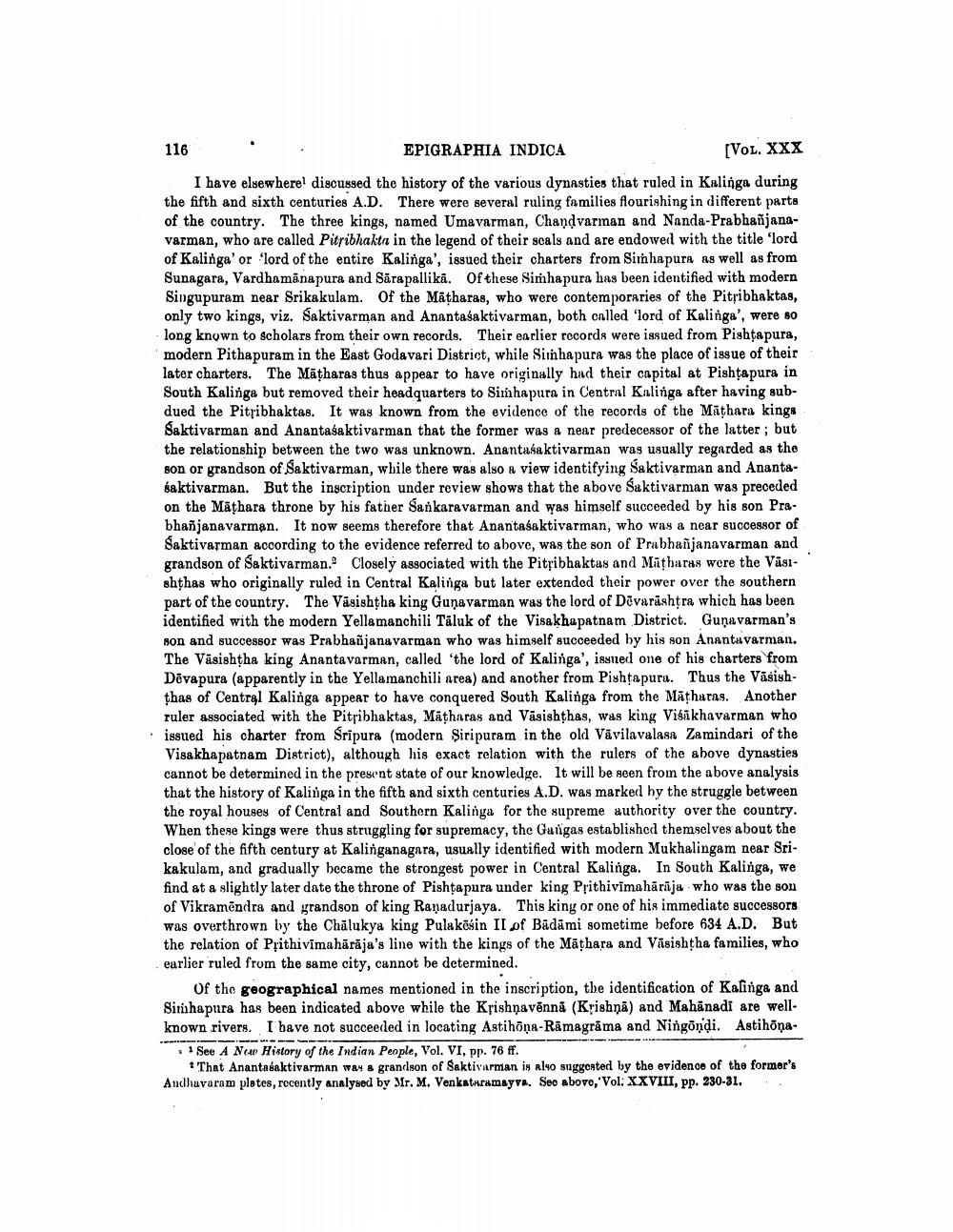________________
116 . . EPIGRAPHIA INDICA
[Vol. XXX I have elsewhere discussed the history of the various dynasties that ruled in Kalinga during the fifth and sixth centuries A.D. There were several ruling families flourishing in different parts of the country. The three kings, named Umavarman, Chandvarman and Nanda-Prabhañjanavarman, who are called Pitribhakta in the legend of their scals and are endowed with the title 'lord of Kalinga' or 'lord of the entire Kalinga', issued their charters from Simhapura as well as from Sunagara, Vardhamanapura and Särapallika. Of these Simhapura has been identified with modern Singupuram near Srikakulam. Of the Mātharas, who were contemporaries of the Pitribhaktas, only two kings, viz. Saktivarman and Anantaśaktivarman, both onlled 'lord of Kalinga', were 80 long known to scholars from their own records. Their earlier rocords were issued from Pishtapura, modern Pithapuram in the East Godavari District, while Siinhapura was the place of issue of their later charters. The Mātharas thus appear to have originally had their capital at Pishtapura in South Kalinga but removed their headquarters to Sinhapura in Central Kalinga after having subdued the Pitribhaktas. It was known from the evidence of the records of the Māthara kings Saktivarman and Anantaśaktivarman that the former was a near predecessor of the latter ; but the relationship between the two was unknown. Anantasaktivarman was usually regarded as the son or grandson of Saktivarman, while there was also a view identifying Saktivarman and Anantasaktivarman. But the inscription under review shows that the above Saktivarman was preceded on the Mathara throne by his father Sankaravarman and was himself succeeded by his son Prabhañjanavarman. It now seems therefore that Anantaśaktivarman, who was a near successor of Saktivarman according to the evidence referred to above, was the son of Prabhasjanavarman and grandson of Saktivarman. Closely associated with the Pitřibhaktas and Mathares were the Vásishthas who originally ruled in Central Kalinga but later extended their power over the southern part of the country. The Vásishtha king Gunavarman was the lord of Divarashtra which has been identified with the modern Yellamanchili Täluk of the Visakhapatnam District. Gunavarman's son and successor was Prabhañjanavarman who was himself succeeded by his son Anantavarman. The Väsishtha king Anantavarman, called 'the lord of Kalinga', issued one of his charters from Dévapura (apparently in the Yellamanchili area) and another from Pishtapuru. Thus the Võsishthas of Central Kalinga appear to have conquered South Kalinga from the Matharas. Another ruler associated with the Pitribhaktas, Matharas and Väsishthas, was king Visakhavarman who issued his charter from Sripura (modern Siripuram in the old Vävilavalasa Zamindari of the Visakhapatnam District), although his exact relation with the rulers of the above dynasties cannot be determined in the present state of our knowledge. It will be seen from the above analysis that the history of Kalinga in the fifth and sixth centuries A.D. was marked by the struggle between the royal houses of Central and Southern Kalinga for the supreme authority over the country. When these kings were thus struggling for supremacy, the Gangas established themselves about the close of the fifth century at Kalinganagara, usually identified with modern Mukhalingam near Srikakulam, and gradually became the strongest power in Central Kalinga. In South Kalinga, we find at a slightly later date the throne of Pishtapura under king Prithivimahārāja who was the son of Vikramēndra and grandson of king Raņadurjaya. This king or one of his immediate successors was overthrown by the Chālukya king Pulakösin II of Bādāmi sometime before 634 A.D. But the relation of Prithivimahārāja's line with the kings of the Māthara and Väsishtha families, who earlier ruled from the same city, cannot be determined.
Of the geographical names mentioned in the inscription, the identification of Kalinga and Sirihapura has been indicated above while the Krishnavēnnå (Krishna) and Mahanadi are wellknown rivers. I have not succeeded in locating Astihāņa-Rāmagrama and Ningöndi. Astihoņa, See A New History of the Indian People, Vol. VI, pp. 76 ff.
* That Anantasaktivarman way a grandson of Saktivarman is also suggested by the evidence of the former's Andhuvaram plotes,rocently analysed by Mr. M. Venkataramayva. See abovo,'Vol: XXVIII, pp. 230-31.




